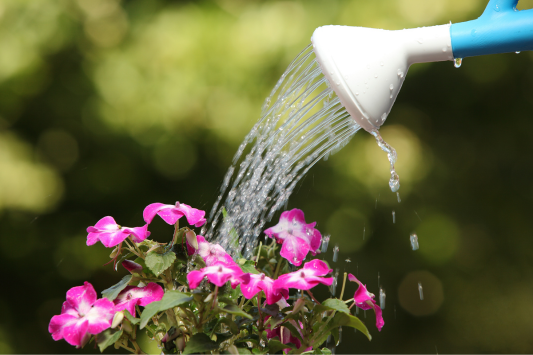How can I protect my plants from extreme heat? Complete guide

How are your plants handling the summer? Are they healthy, or maybe...?
>> They have started to wilt.
>> Several leaves are turning brown.
>> And also, the lawn has developed quite a few yellow spots.
All these symptoms are a clear sign that your garden is not well-protected against the high temperatures.
And it’s a pretty serious matter.
The heat doesn’t just affect us; it can also be quite a challenge for our plants (and they can’t jump into the pool to cool off!).
Many species (like those from tropical climates or grown in greenhouses) cannot tolerate direct sunlight, and temperatures above 30°C cause the soil and plants to dry out.
And the trend is that this situation will become more frequent: in Spain, we are already noticing the effects of climate change, which is causing heatwaves to last longer and reach higher temperatures.
That's why protecting our plants from the heat is more important than ever today.
And with some simple care tips, like the ones we’ll explain in this article, we can keep our gardens in perfect condition throughout the summer.
Let's get started!
Tips to Help Your Plants Endure High Temperatures
Let Your Lawn Grow
One of the first to suffer from the heat is the lawn, which begins to dry out and turn yellow.
Direct sunlight burns the leaves and dries out the soil. And unlike other plants, keeping the entire lawn in shade during the day is almost impossible. Unless we have a very small garden, there will always be a part exposed to direct sunlight for several hours.
So, what can we do?
The best thing is to increase the mowing height.
Instead of the usual three centimeters we leave the rest of the year, in summer, we’ll let it grow up to five. This way, the leaves can retain more water and protect the soil from the sun's rays, maintaining moisture.
Cover the Soil with Mulch
This advice applies to the lawn, potted plants, and the rest of the garden.
A generous layer of substrate acts as a natural insulator against extreme temperatures in winter and summer. Additionally, it helps retain moisture in the soil.
If you haven't been doing this yet, try it, and you’ll see how your plants appreciate it.
Use Awnings and Nets to Create Shade
If an area of your garden receives direct sunlight for many hours a day, you can use an awning or shade netting. Both create a pleasant shade that prevents the leaves from burning.
For large gardens with multiple areas, you can install sail awnings, which can be anchored to trees, walls, or stakes to provide shade in specific areas (like flower beds).
Group Plants Together
Place several plants together to form a humid microclimate among them.
If you put these groups in partial shade and cover the soil with a layer of mulch, you'll help keep your plants cool with less water.
Fertilize in Spring, Not in Summer
It's not advisable to fertilize during the hottest months. Fertilizer can absorb the heat of the sun and end up harming our plants.
Instead, apply fertilizer in spring. This way, our plants will have time to absorb the nutrients and will grow more resilient for the summer.
Be Careful with Pests
Plants weakened by the heat and more active pests... it’s an explosive combination.
With high temperatures, fungi and insects are on the lookout to settle in our garden. If we don't prevent this, it's likely they will end up weakening our plants.
If you notice any of these unwanted visitors appearing in your garden, act quickly by applying a specific plant protection product.
Cool Your Plants with Sprayers
Our flowers are like us: when they're too hot, a bit of water feels wonderful.
You can use a misting sprayer on the leaves and flowers to reduce their temperature and protect them from the heat.
This method gives the plant enough moisture to stay cool but not so much as to encourage the growth of fungi.
However, remember to do this during the hours with the least sun. Otherwise, the droplets could act as a magnifying glass and burn the leaves.
Water Very Early or at Night
This tip is a classic for saving water because it helps prevent evaporation during watering.
But also, as with the previous point, if we water in full sun during summer, the leaves may end up burning due to the magnifying effect of the droplets.
The Best Protection Against the Heat Is a Well-Designed Garden
We never tire of saying it: a well-designed garden is the best way to save water and ensure your plants can withstand the rigors of summer, wind, and winter cold.
And some plants are very well adapted to our climate and can easily handle the summer heat.
Or for the more sensitive ones, you can also apply small "tricks," like creating natural barriers and shade with trees and shrubs.
Would you like us to help you renovate your garden and create a more sustainable and resilient ecosystem, resistant to heat and drought?
At Viveros González, we have many years of experience in garden design, so we know all the secrets to creating a garden that looks healthy and beautiful any month of the year. All you have to do is click here and tell us your case.
We’ll take care of everything.

 English
English Spanish
Spanish